Definition, Advantages - Biofertilizers | 11th Microbiology : Chapter 11 : Agricultural Microbiology
Chapter: 11th Microbiology : Chapter 11 : Agricultural Microbiology
Biofertilizers
Biofertilizers
In India, the availability and affordability of fossil fuel
based chemical fertilizers at the farm level have been ensured only through
imports and subsidies. Indiscriminate and imbalanced use of chemical
fertilizers, especially urea, along with chemical pesticides and unavailability
of organic manures has led to considerable reduction in soil health.
Biofertilizers can act as a renewable supplement to chemical fertilizers and organic
manures. They have the capacity to produce natural resistance in plants against
pests and soil borne diseases, adding fertility to soil.
Nitrogen fixation by leguminous and other crops is reported to
be 44 million metric tons per annum. The appropriate strain of Rhizobium can increase the crop yield up
to 10-35%. Also, residual N is
beneficial for the next crops grown in the same field.
It has been estimated that 40-250 kg N / hectare(ha) / year is
fixed by different legume crops by the microbial activities of Rhizobium.
Definition
Biofertilizers are preparations containing beneficial micro
organisms like N2 fixers, PO4 solubilizers in a viable
static state intended for seed or soil application and designed to improve soil
fertility.
Advantages
1.
They reduce the need for chemical fertilizers.
2.
They provide the plant with certain vitamins, plant growth
promoting substances and increase the vigour of the plant.
3.
It is cheap and cost effective.
Based on the nutrients that they provide, biofertilizers are of
the following types
Nitrogenous biofertilizers-
·
Rhizobium,
·
Azotobacter,
·
Azospirillum
·
Frankia
Phosphate solubilisers
·
Bacillus
·
VAM
Rhizobium
Rhizobium – legume symbiosis is
a well studied plant microbe
interaction and Rhizobium is the most
extensively used nitrogenous
biofertilizer in India.
Rhizobium is a gram negative,
non-spore forming aerobic bacillus
inhabiting the soil in a free living state. The colonies of Rhizobium on YEMA (Yeast Extract
Mannitol Agar) plate are gummy, pale white in colour (Figure 11.7). They can
establish symbiotic relationship with leguminous plants and fix atmospheric
nitrogen thereby greatly improving soil fertility.

Mass production of Rhizobium
The flowchart explaining the mass production of Rhizobium biofertilizer is given below

Method of application of Rhizobium to plants
Carrier based Rhizobium
inoculants are mixed with water to form slurry to which the seeds of plants are
added (Figure 11.8). The coated seeds are dried in shade and used for sowing.
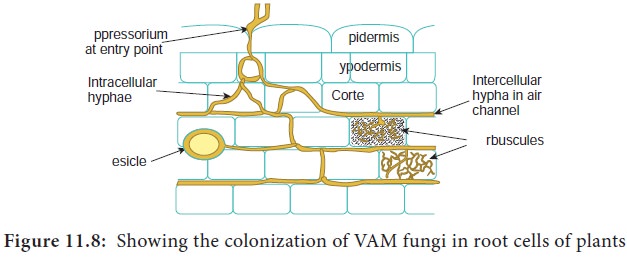
Phosphate Solubilizers
Several soil bacteria like Pseudomonas
and Bacillus possess the ability to
convert insoluble mineral phosphates into soluble form by secreting organic
acids thereby making it available to plants.
For mass cultivation and inoculant preparation, the cultures are
grown in Pikovaskaya broth for 7-18 days and mixed in suitable carrier like
peat or lignite. After curing for a week, the inoculants are packed and made
ready for use in a similar manner as Rhizobium
inoculants.
VAM
Mycorrhiza means fungus root. It describes the symbiotic
association between plant and fungus. Vesicular Arbuscular Mycorrhiza (VAM) is
an endomycorrhiza which is used as a fungal biofertilizer. They mobilize the
soluble phosphates in the root zone of plants and satisfy the phosphorus
nutrition of plants.
Morphology
VAM is an example of endomycorrhiza meaning, the storage
organelles of phosphates like vesicles and arbuscles are seen intracellularly.
Vesicle is a globose structure and arbuscle is a tree like branching structure
present in the root cortical cells (Figure 11.9). VAM fungi are naturally most
prevalent in angiosperms. gymnosperms, pteridophytes and bryophytes.
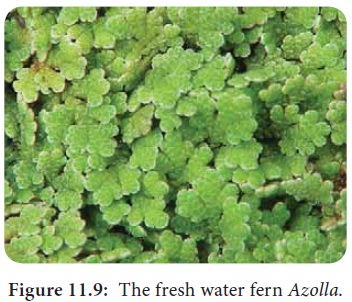
Mass production
Root based inoculum is used for preparing VAM biofertilizer
(Figure 11.10). The selected spores of VAM fungi are allowed to infect plants
like onion, sorghum and other grasses. After 3-4 months, the roots along with
the soil are macerated or pelleted with an inert material and packed in
polythene pouches which can be used as biofertilizer.
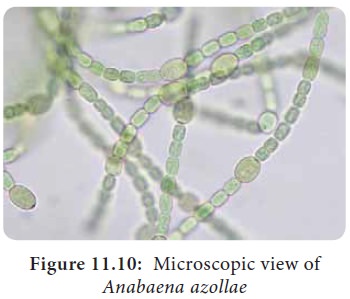
Cyanobacteria / Blue green Algae
Blue green algae are single celled or filamentous prokaryote capable of nitrogen fixation and photosynthesis.
Most of the filamentous forms have
specialized large, thick walled cells called heterocysts which are sites of
nitrogen fixation.
Example: Nostoc, Anabaena is examples for filamentous
BGA. Gleocapsa is an example of
unicellular BGA. Some of the filamentous forms do not possess heterocysts but
still fix atmospheric nitrogen. Since they need standing water for their
growth, BGA can effectively colonize paddy fields and enrich the soil with
nitrogen.
Mass cultivation of BGA
Applying BGA to paddy fields can reduce the amount of chemical
nitrogenous fertilizer applied for the growth of paddy crop. Therefore
cultivation of BGA in large quantities is necessary. Mass cultivation of BGA
has the following steps.
1. Isolation of BGA
2. Mass cultivation of BGA
Isolation of BGA
BGA can be isolated from soil or paddy fields. Appropriate
dilutions from serially diluted algal sample are inoculated in the liquid
flasks containing algal media like BG-11 or Pringsheim’s media. After several
weeks of incubation at 28°C, the individual colonies are picked up, identified
and stored. This can be used as starter culture for mass cultivation. Mass
culture can be done in 2 ways.
Mass cultivation of BGA
1. Open air shallow culture:
The dried algal flakes around 10kg/ha can be applied in paddy
fields after transplantation.
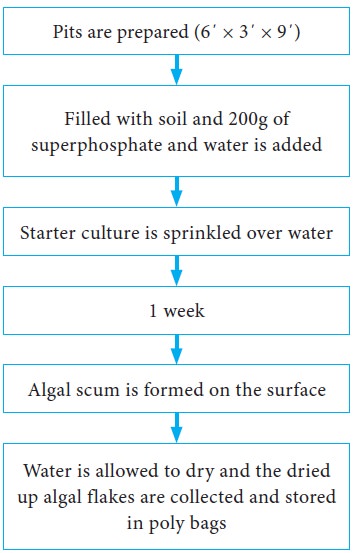
Azolla
Azolla is a floating
freshwater fern. The plant has a
branched stem, deeply bilobed leaves which are arranged alternately on the stem
and each leaf has a dorsal and ventral lobe (Figure 11.9). The dorsal lobe
houses the cyanobacterial symbiont Anabaena
azollae (Figure 11.10). The fern and
the cyanobacteria exhibit symbiotic relationship in which Anabaena provides the fern with fixed nitrogen and fern provides
niche for the cyanobacteria free from competition from other microorganisms.
Azolla can be used as a nitrogenous biofertilizer for paddy crop. When applied into the paddy fields, Azolla provides nitrogen nutrition to standing rice crop and can reduce the need for synthetic fertilizers.
Mass multiplication of Azolla
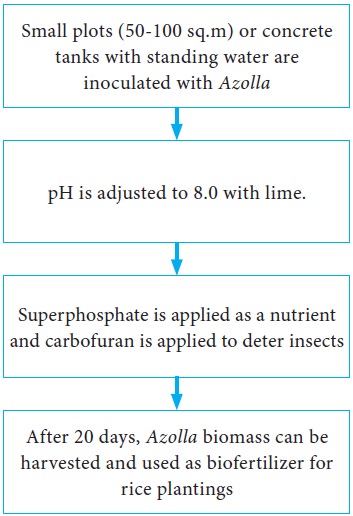
Method of application of Azolla in rice fields
Azolla is grown on the flooded rice fields prior to planting for 2-3weeks. Then water is drained and Azolla is incorporated into the soil followed by rice transplantation within a week’s time.
Related Topics